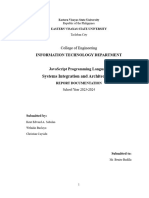0% found this document useful (0 votes)
12 views4 pagesInto Js
The document outlines the evolution of JavaScript from its inception in 1995 as a simple scripting language to its current status as a versatile tool for frontend, backend, and mobile development. It discusses key milestones such as standardization through ECMAScript, the rise of modern frameworks, and the introduction of Node.js for server-side development. Despite its challenges, JavaScript's adaptability and extensive ecosystem position it as a foundational technology in software development.
Uploaded by
Akinola KolawoleCopyright
© © All Rights Reserved
We take content rights seriously. If you suspect this is your content, claim it here.
Available Formats
Download as PDF, TXT or read online on Scribd
0% found this document useful (0 votes)
12 views4 pagesInto Js
The document outlines the evolution of JavaScript from its inception in 1995 as a simple scripting language to its current status as a versatile tool for frontend, backend, and mobile development. It discusses key milestones such as standardization through ECMAScript, the rise of modern frameworks, and the introduction of Node.js for server-side development. Despite its challenges, JavaScript's adaptability and extensive ecosystem position it as a foundational technology in software development.
Uploaded by
Akinola KolawoleCopyright
© © All Rights Reserved
We take content rights seriously. If you suspect this is your content, claim it here.
Available Formats
Download as PDF, TXT or read online on Scribd
/ 4























































































